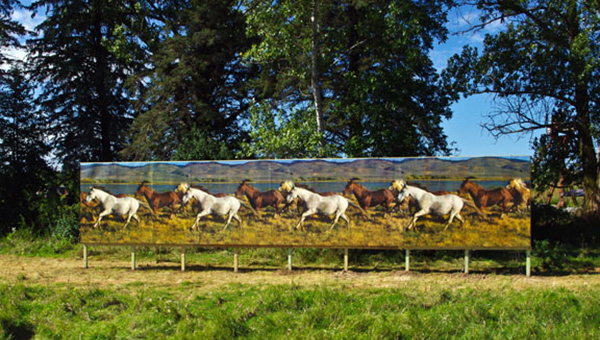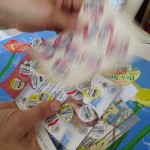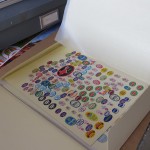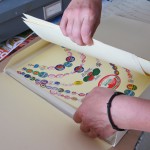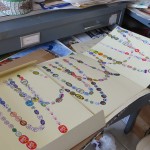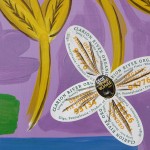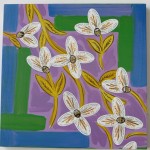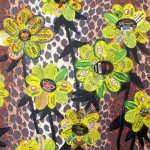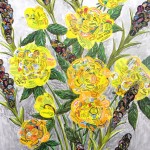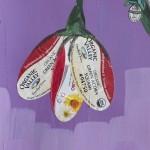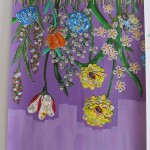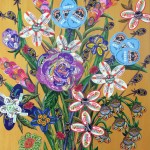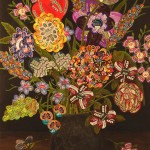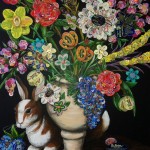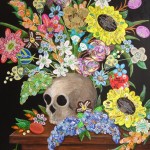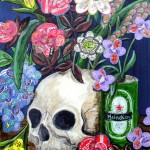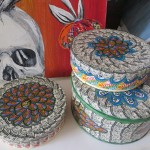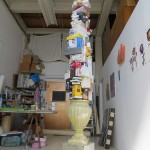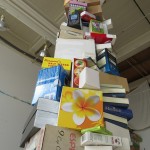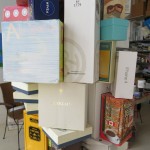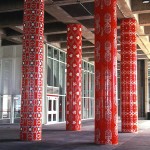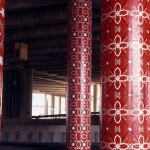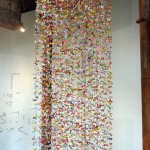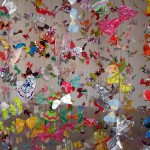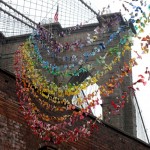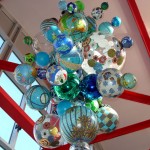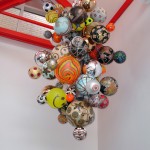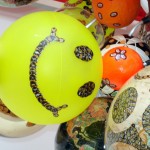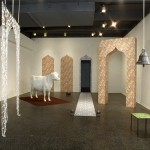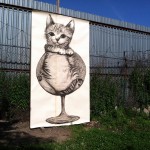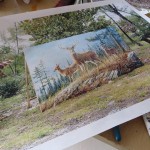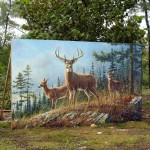Luisa Caldwell
The Apian Way was lined with cypress trees I’m told. Luisa Caldwell, in her Brooklyn studio, is working on something that resembles one of those Roman trees. Biography is a piece of all this. Caldwell’s mother was from Italy and the contemporary and historical culture of the place summons her attention. She speaks the language; she has lived there in the past and still spends regular bouts of time there. The work here in Brooklyn, tethered as it is to such an autobiographical eye toward Italy, is also something of a squabble between nature and its image, between nature and its history or perhaps between nature and its price point.
Caldwell’s work with ‘stickers’ is probably her best known. She works with those little oval shaped stickers we all find affixed –astonishingly– one by one, to each piece of fruit we buy. The stickers being in themselves the sign that agribusiness has spread its managerial and technocratic tentacles to the micro level, seizing seemingly each piece of produce individually as it tumbles earthward from the tree: nature stamped with a bar code.
Caldwell began working with these stickers in the mid 2000’s showing them at Florence Lynch Gallery (http://www.lynchtham.com/). One show at Lynch was titled Floralistic. The stickers, there, were arranged as flower petals and buds. They were grouped into something resembling conventional still lives or arranged as components of traditional Vanitas. Mostly of a smallish size, the works are a festival of the irredeemably kitschy in their celebration of glitter and shine and their pastiche of canonical forms. Through this practice Caldwell detours the agribiz utilitarian label of ownership and provenance and has it pose as mass-produced decoration. Thus Caldwell, the ‘consumer,’ tinkers with the literal sign of price and provenance and returns it to the hungry public as a recherché budding flower.
In doing so the artist is taking a bite out of the gap between Capitalism and life. The Kitsch surfaces of consumer-land draw Caldwell in: they are, after all, very seductive. That aforementioned Cypress tree in her studio, the one that also wants to be a Corinthian column pretending to be a Christmas stocking, to wit it is composed of the packaging, boxes and signage of commodity life all mashed together to shape up as the tree come column. As it reaches toward her studio ceiling it snags all the confections of the average suburban mall. Not all of it is obvious bling. For sure there are I-phone boxes, and yes there is a turquoise Tiffany box, too. But there is also a broad range of less ostentatious stuff, the stuff of day-to-day consuming aka day-to-day living. There are cracker boxes, salt-water taffy packages, boxes from coffee makers and liquor bottles, the stuff of dawn until the last drunken minute of the day. And of course all the boxes are empty; empty vessels doing their job. The contents? They are all off somewhere else being celebrated for their ‘use’ value. Caldwell, left working with the detritus of the shopping mall, sews and glues it all back together, again rerouting the signs, this time to shout out that, maybe, there is another voice to be heard between all those busy, noisy buyers and sellers.
An earlier piece of Caldwell’s tackling this turf war between utility and its garnishments embalms the utility of architecture in Glam Decor. Installed as part of one of The Sculpture Center’s (http://www.sculpture-center.org/) outings on Roosevelt Island, in Columns (1996) Caldwell covered/ papered existing concrete columns in garishly screen-printed paper. Utility and eye-candy jousted. The prize was to see which would appear as the ruin of the other. Then, a decade later, resonating with the Columns’ piece, Caldwell invades the vertical architecture of Smack Mellon Gallery in Brooklyn with Color Falls, (2006). Actual candy this time, many, many, many candy wrappers climb from floor to ceiling delicately suspended on thread. Emptied, twinkling wrappers; consumed confections? The work itself is beckoning, not toward “nothing” i.e. the emptiness of the wrappers, rather it directs us toward the initial layer –the wrapper, the come-on, the promise itself. One imagines the candy in fact not eaten instead discarded somewhere off screen, useless, tossed aside, irrelevant. The wrappers? Very sweet.
In several of her more ambitious pieces –way outside the studio– Caldwell employs commercial wall posters of animals. Large in format these are off-the-shelf photo-based images of deer or horses. As Caldwell has used them, they can run as large as 12 feet high and up to 44 feet long. They stand like billboards for the forest’s inhabitants. With these Caldwell has engineered the moment when cloyingly rendered nature pays a call on nature. In one case, We Are Not From Here, 2009, a pastiche of Edward Landseer’s notoriously kitsch painting Monarch of the Glen, 1851,rears its head in the Florida Keys where Caldwell installed it under the auspices of Sculpture Key West (http://sculpturekeywest.org/) It is as clichéd an image of nature as can be had. But importantly it is nature hovering in a space between being majestically untamed and aristocratically owned. The original Landseer was commissioned for the House of Lords in London. But when the artist turned the painting over the aristocrats tried to stiff him on the fee. He sold it elsewhere and it went on to become one of the most widely reproduced images of the nineteenth and twentieth centuries — selling everything from Pears soap, to Glenfiddich whiskey, Deer Park water and Hartford insurance. The endnote in Caldwell’s piece is an equally comic turn. Proudly erect in the Florida Keys stands the ruin of kitsch culture; Landseer’s deer, untamed, has gone home to Florida, on his way north no doubt to Lake Buena Vista — Disney World. Bigger and more ambitious yet, on Caldwell’s behalf, is Running Fence from 2010. This work, funded by the Jerome Foundation, (http://www.jeromefdn.org/) is a 44-foot long poster of galloping horses installed at Franconia Sculpture Park. (http://www.franconia.org/) The boilerplate beauty of stallions at full gallop rhymes simultaneously with Muybridge’s motion studies, TV shows like Bonanza, Budweiser ads and Richard Prince’s Marlboro Man. Cultural boundaries tumble as the gleam of the spectacle races through the forest. If we can keep up with the horses we might see that Caldwell now has us watching nature chase after its own exchange value.
